Transforming your home into a serene and stylish sanctuary with Japandi design principles can be a deeply fulfilling experience. Embracing this fusion of Japanese minimalism and Scandinavian functionality brings a sense of calm and order to any space. The simplicity and elegance of Japandi style not only enhance the visual appeal of your home but also create an environment that promotes relaxation and balance.
As you dive into the details of Japandi decor, you’ll find that the process of curating a space with clean lines, natural materials, and muted colors can be both exciting and rewarding. There’s a satisfaction that comes from seeing your home evolve into a peaceful retreat, where every piece of furniture and decor serves a purpose and contributes to an overall sense of tranquility. The subtlety of the design allows for a personal touch while maintaining a refined aesthetic.
The emotional impact of a well-designed Japandi space extends beyond visual beauty; it touches on a deeper level of contentment and well-being. This style encourages mindfulness and simplicity, fostering an environment where you can unwind and recharge. As you embrace these design principles, you’ll likely find that the transformation of your home brings not only a refreshed space but also a renewed sense of peace and satisfaction.
1. Neutral Color Palette:





Sticking to a neutral color palette, such as soft beiges, grays, and whites, is essential for achieving a Japandi-inspired home. This approach creates a calm, timeless atmosphere that enhances the overall tranquility and elegance of the space. Here’s how to effectively use these colors:
- Walls and Ceilings: Paint walls and ceilings in soft shades of white, beige, or light gray. These colors help to reflect natural light, making rooms feel brighter and more spacious.
- Furniture: Choose furniture in neutral tones to ensure it blends seamlessly with the rest of the decor. Pieces in light wood, soft grays, or creamy beiges can complement the minimalist aesthetic and create a cohesive look.
- Textiles: Use neutral-colored textiles for curtains, cushions, and rugs. Opt for materials like linen, wool, or cotton in shades that match or complement the overall color scheme, adding texture and comfort without overwhelming the space.
- Decor and Accents: Incorporate decor items such as vases, lamps, and artwork in subtle, neutral tones. This ensures that these elements enhance rather than compete with the calm ambiance of the room.
- Flooring: If possible, choose flooring in light, neutral colors, such as pale wood or beige carpets. This will help maintain the airy, open feel of the space.
- Balance and Contrast: While sticking to neutrals, you can create visual interest by incorporating various textures and finishes, such as matte vs. glossy surfaces or soft vs. coarse materials. This adds depth and prevents the space from feeling flat.
By focusing on a neutral color palette, you create a serene and timeless environment that complements the Japandi style’s emphasis on simplicity and elegance.
2. Natural Wood Elements:

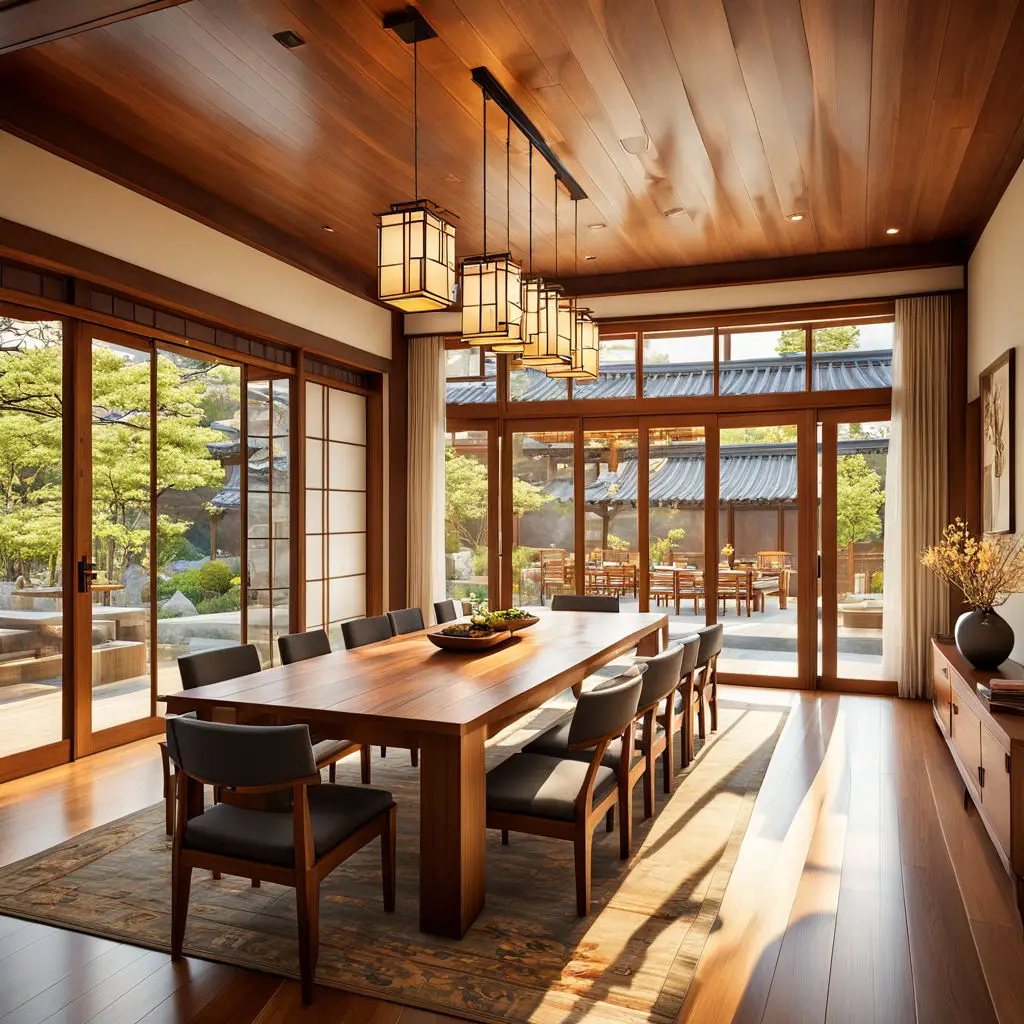



Incorporating light wood elements is a key aspect of Japandi style, bringing warmth and a natural touch to your home. Here’s how to effectively use light wood in your decor:
- Furniture: Choose pieces made from light wood, such as oak, ash, or maple, for a warm and inviting look. This could include dining tables, coffee tables, bed frames, and chairs. The natural grain and soft tones of light wood create a serene and cohesive aesthetic.
- Accent Pieces: Incorporate light wood in accent items like picture frames, trays, or decorative bowls. These smaller touches can enhance the natural feel of the space without dominating it.
- Flooring: Opt for light wood flooring or wooden tiles. This not only adds warmth but also helps to create a cohesive and harmonious look throughout the room.
- Wall Panels or Beams: Use light wood paneling or exposed wooden beams to add architectural interest and a touch of natural beauty. This works especially well in open-plan spaces or as a feature wall.
- Shelving: Install floating shelves or built-in units made from light wood. These can be used to display books, plants, or other decor items while keeping the look clean and uncluttered.
- Decorative Details: Incorporate light wood in smaller decorative details, such as lamps, mirrors with wooden frames, or wooden planters. These details can tie together the room’s design and contribute to the overall warmth.
- Mix with Natural Elements: Combine light wood with other natural materials, such as stone or ceramics, to create a balanced and harmonious look. For example, a light wood table paired with a ceramic vase or a wooden shelf above a stone fireplace can enhance the natural, organic feel of the space.
By integrating light wood elements thoughtfully, you enhance the Japandi style’s emphasis on natural materials and create a warm, welcoming environment that remains stylish and serene.
3. Minimalist Furniture:





Choosing minimalist furniture with clean lines and low profiles is fundamental to achieving the Japandi style’s serene and uncluttered look. Here’s how to select and use minimalist furniture effectively:
- Clean Lines: Opt for furniture that features straight, unembellished lines. This includes simple rectangular or square shapes for tables, sofas, and beds. Avoid overly ornate or intricate designs, as they can disrupt the minimalist aesthetic.
- Low-Profile Designs: Select low-profile furniture that sits close to the ground. This can create a sense of spaciousness and help maintain a calm, grounded feel in the room. Examples include low-slung sofas, platform beds, and streamlined coffee tables.
- Neutral Colors: Choose furniture in neutral tones such as white, beige, or light gray. These colors blend seamlessly with the Japandi color palette and contribute to a cohesive and tranquil environment.
- Functional Pieces: Look for furniture that is not only aesthetically pleasing but also practical. Pieces with built-in storage, such as a coffee table with drawers or a bed with under-bed storage, can help keep the space tidy and uncluttered.
- Natural Materials: Incorporate furniture made from natural materials like wood, leather, or stone. Light wood is particularly effective in Japandi style, adding warmth and texture without overwhelming the space.
- Simple Shapes: Choose furniture with simple, geometric shapes. This can include round tables, rectangular sofas, or square ottomans. These shapes enhance the minimalist look and keep the space visually clean.
- Minimal Accents: If incorporating accents, choose pieces that are subtle and complement the overall design. For example, a sleek metal lamp or a simple ceramic vase can add interest without adding clutter.
By focusing on these aspects of minimalist furniture, you can create a Japandi-inspired space that is both functional and elegantly simple, enhancing the overall serenity and balance of your home.
4. Zen Gardens:





Creating small indoor Zen gardens is a wonderful way to bring tranquility and mindfulness into your Japandi-inspired home. These gardens are designed to evoke a sense of peace and simplicity, and they align perfectly with the minimalist ethos of Japandi style. Here’s how to set up a serene Zen garden:
- Choose the Container: Select a shallow tray or box as the base for your Zen garden. Materials like wood, ceramic, or metal can work well, depending on your aesthetic preferences. The container should be large enough to allow for a pleasing arrangement of sand, stones, and plants.
- Add Sand: Fill the container with a layer of fine sand. This represents water or space in Zen philosophy and provides a smooth, calming surface. You can use a small rake to create gentle patterns in the sand, mimicking the ripples of water or the contours of a landscape.
- Incorporate Stones: Arrange smooth, natural stones or pebbles in the sand. These stones can symbolize mountains, islands, or other natural features. Arrange them thoughtfully to create a balanced and harmonious layout.
- Include Minimalistic Plants: Choose small, low-maintenance plants to add a touch of greenery. Options like succulents, small bonsai trees, or even a single sprig of bamboo work well. Arrange the plants sparingly to maintain the Zen garden’s minimalist aesthetic.
- Add Decorative Elements: Consider incorporating a few additional elements like a small figurine, a piece of driftwood, or a tiny bridge. Ensure these items are simple and do not overwhelm the garden’s tranquil vibe.
- Create a Relaxing Spot: Place your Zen garden in a spot where you can easily enjoy it. This could be on a desk, a coffee table, or a shelf. It should be in a location where you can pause and reflect, adding to the garden’s calming effect.
- Maintain Simplicity: Keep the design minimal and uncluttered. The goal is to create a space that invites contemplation and relaxation, so avoid adding too many elements that could distract from the serene ambiance.
By incorporating these elements, you create a small indoor Zen garden that enhances the Japandi style’s focus on peace, simplicity, and natural beauty.
5. Japanese Sliding Doors:





Using Japanese sliding doors, or shoji screens, is an excellent way to divide spaces in a Japandi-style home while maintaining a sense of openness and fluidity. Here’s how to effectively incorporate them:
- Shoji Screens: These traditional Japanese screens are typically made with a wooden frame and translucent paper or fabric panels. They are ideal for creating flexible spaces without blocking natural light. Shoji screens can be used to divide a room into smaller areas or to provide privacy in a subtle, elegant way.
- Sliding Doors: Opt for sliding doors with clean lines and minimalist designs. Sliding doors, whether made of wood, glass, or a combination of materials, can help you partition spaces without taking up additional room for door swings. They are practical for both small and large areas and contribute to a streamlined look.
- Material Choices: Choose materials that align with Japandi aesthetics. For shoji screens, traditional rice paper or frosted glass can create a soft, diffused light. For sliding doors, consider materials like light wood, matte glass, or even metal with minimalist designs.
- Color and Design: Keep the color palette neutral and consistent with the rest of your decor. Light woods or neutral-colored frames work best, as they blend seamlessly with the Japandi style’s emphasis on simplicity and harmony. Simple patterns or plain designs will complement the minimalist look.
- Functionality: Ensure the sliding mechanism is smooth and reliable. Quality hardware is essential for easy operation and durability. If you’re using shoji screens, check that they fit securely in their tracks and can be moved effortlessly.
- Integration: Position the sliding doors or shoji screens where they will enhance the flow of the space. For example, use them to create a private area within an open-plan living room or to separate a bedroom from a home office. They should provide a functional division while maintaining a cohesive look with the rest of the decor.
- Maintenance: Regularly clean and maintain your sliding doors or shoji screens to keep them looking their best. For shoji screens, dust the panels and check for any damage to the paper. For sliding doors, clean the glass or wood and ensure the tracks are free from debris.
By incorporating Japanese sliding doors or shoji screens thoughtfully, you can achieve a stylish and functional way to define spaces in your home while staying true to the Japandi style’s principles of simplicity and elegance.
6. Indoor Plants:

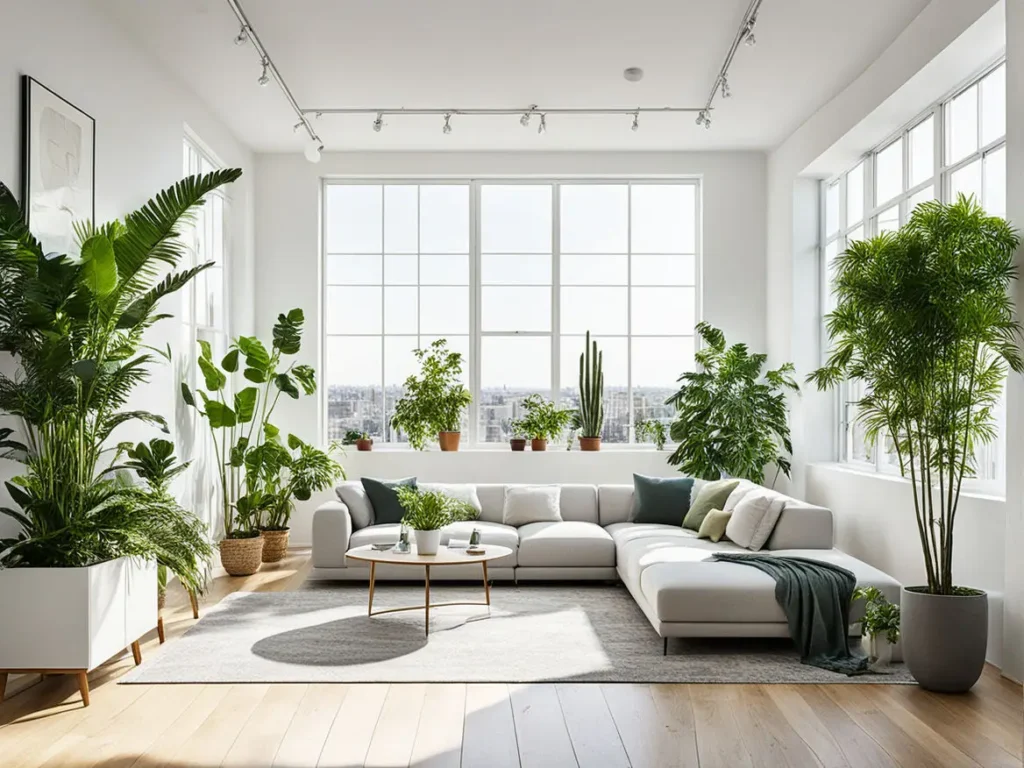



Incorporating indoor plants into your Japandi-style home is a wonderful way to bring nature indoors and enhance the fresh, organic atmosphere that defines this design aesthetic. Selecting low-maintenance plants like bamboo, ferns, or succulents aligns with the simplicity and practicality of Japandi decor.
- Bamboo: Known for its resilience and ease of care, bamboo is a perfect choice for a Japandi home. Its tall, slender stalks add vertical interest and a touch of Zen to any space. Place bamboo in minimalist containers or pots that complement your neutral color palette for a harmonious look.
- Ferns: Ferns are lush and elegant, adding a soft, natural texture to your interiors. Their feathery fronds bring a sense of tranquility and are particularly well-suited to areas with indirect light, such as bathrooms or living rooms.
- Succulents: These hardy plants are not only low-maintenance but also come in various shapes and sizes, making them versatile for different spaces. Succulents’ clean lines and sculptural forms are a perfect match for the Japandi aesthetic, adding subtle beauty without overwhelming the space.
By integrating these plants into your decor, you can achieve a fresh and calming environment. Their natural beauty complements the neutral tones and natural materials typical of Japandi style, creating a serene and balanced home.
7. Clean Lines:

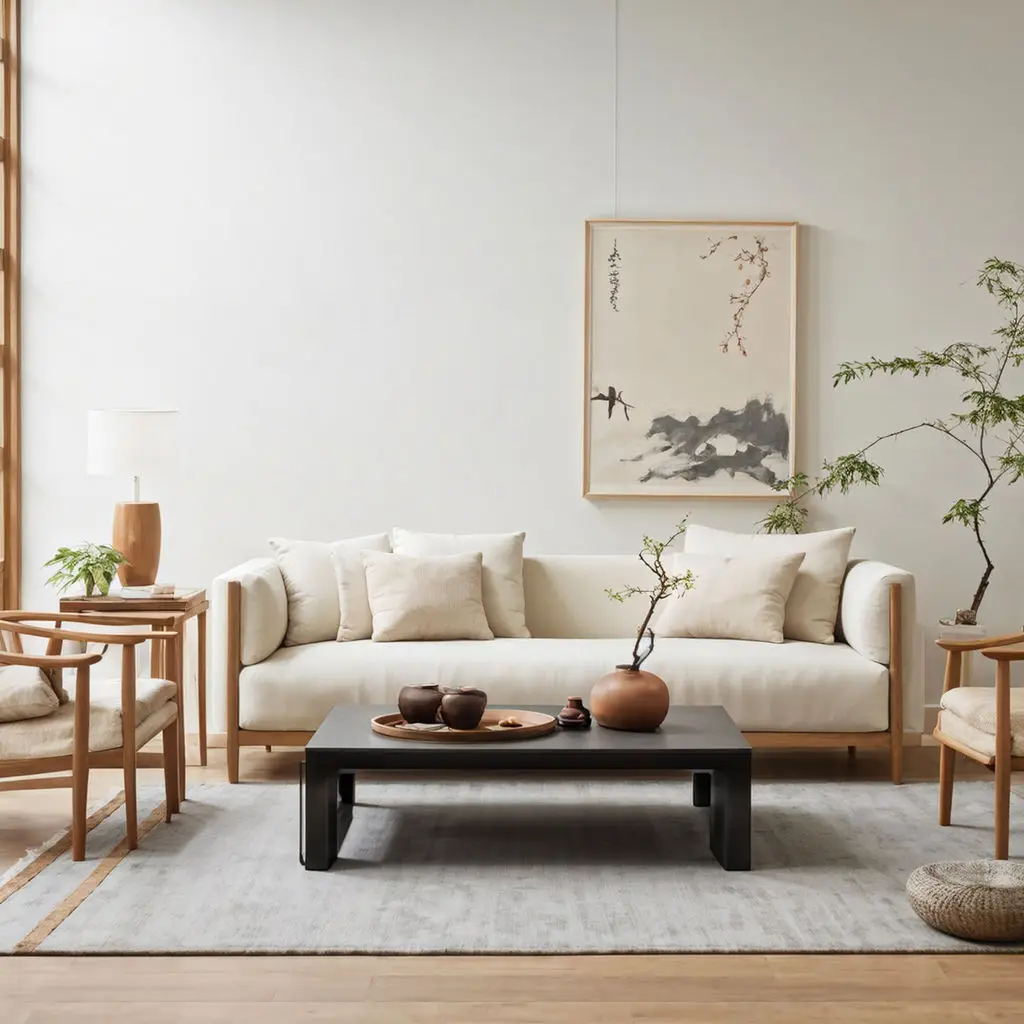



Focusing on clean lines is central to achieving the streamlined, uncluttered look that defines Japandi style. This approach emphasizes simplicity and precision, creating a sense of order and calm in your home.
- Furniture: Opt for furniture with straight edges and smooth surfaces, avoiding ornate details or intricate carvings. Think of pieces like a rectangular wooden dining table, a sleek low-profile sofa, or a minimalist bed frame. The clean lines of these items help maintain visual clarity and make the space feel more open.
- Decor: Choose decor items that also adhere to the principle of simplicity. For example, opt for rectangular or square wall art, linear shelving, and straight-edged vases or planters. Even lighting fixtures can follow this aesthetic, with simple pendant lights or linear chandeliers that add elegance without excess.
- Layout: The arrangement of furniture and decor should follow these straight lines as well. Align pieces with walls and other furnishings to create a cohesive, balanced look. Avoid cluttering spaces with too many angles or curves, as this can disrupt the flow and harmony of the room.
By focusing on simple, straight lines throughout your furniture and decor, you maintain the minimalist, harmonious atmosphere that is key to Japandi style. This approach not only creates a visually appealing space but also contributes to a sense of peace and relaxation in your home.
8. Subtle Patterns:





Incorporating subtle patterns and textures is an effective way to add visual interest to a Japandi-style home while maintaining its serene and minimalist aesthetic. The key is to choose patterns that are understated and harmonize with the overall design, ensuring they enhance rather than dominate the space.
- Soft Stripes: Stripes in neutral tones, such as beige, gray, or soft pastels, can add a gentle rhythm to a room. Consider incorporating these into textiles like cushions, throws, or area rugs. The linear nature of stripes aligns with the Japandi focus on clean lines, adding a touch of sophistication without disrupting the calm atmosphere.
- Gentle Geometric Designs: Simple geometric patterns, such as small triangles, hexagons, or circles, can be introduced through decor items like curtains, bedding, or wall art. These patterns should be subtle, using muted colors that blend seamlessly with the surrounding neutral palette. Geometric designs can add a modern touch while maintaining the minimalist integrity of the space.
- Textured Fabrics: Beyond visual patterns, consider introducing texture through fabrics like linen, wool, or woven materials. These textures add depth and interest to the space without the need for bold prints or colors. A textured throw on a sofa or a woven rug on the floor can contribute to the overall warmth and coziness of the room.
- Patterned Ceramics: Subtle patterns can also be introduced through ceramics, such as vases, bowls, or decorative plates. Opt for pieces with simple, hand-drawn designs or light engraving that reflect the natural and artisanal qualities of Japandi style.
By using subtle patterns and textures, you can create a space that feels both inviting and visually engaging while staying true to the minimalist and harmonious principles of Japandi design.
9. Simplicity in Decor:

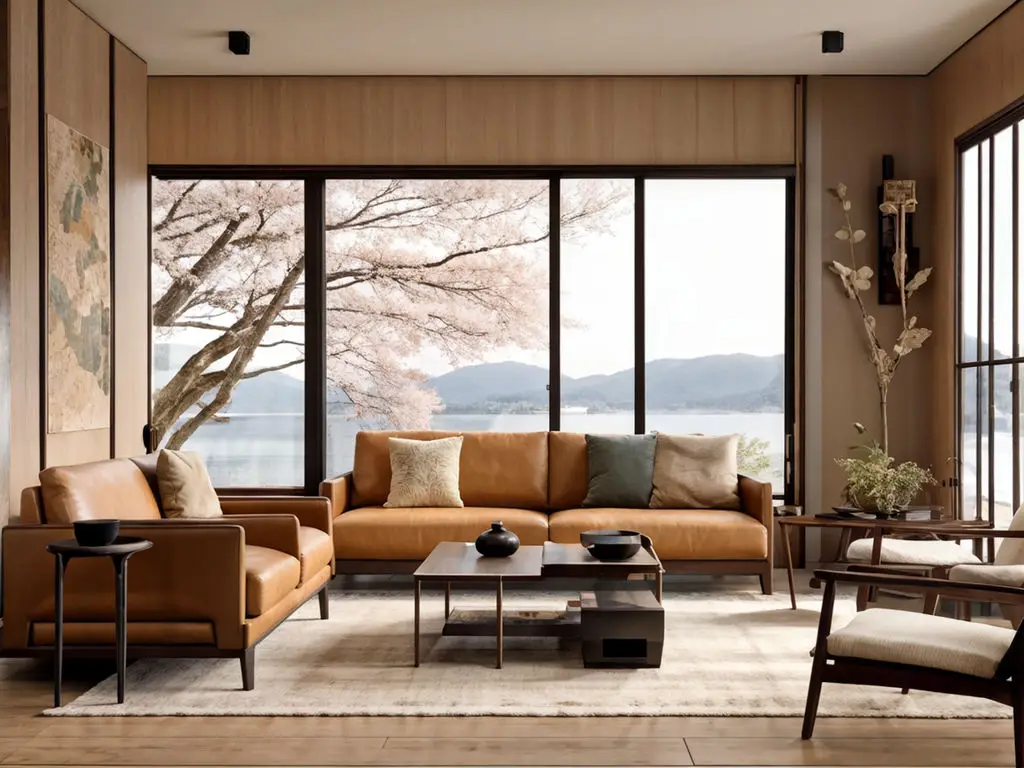
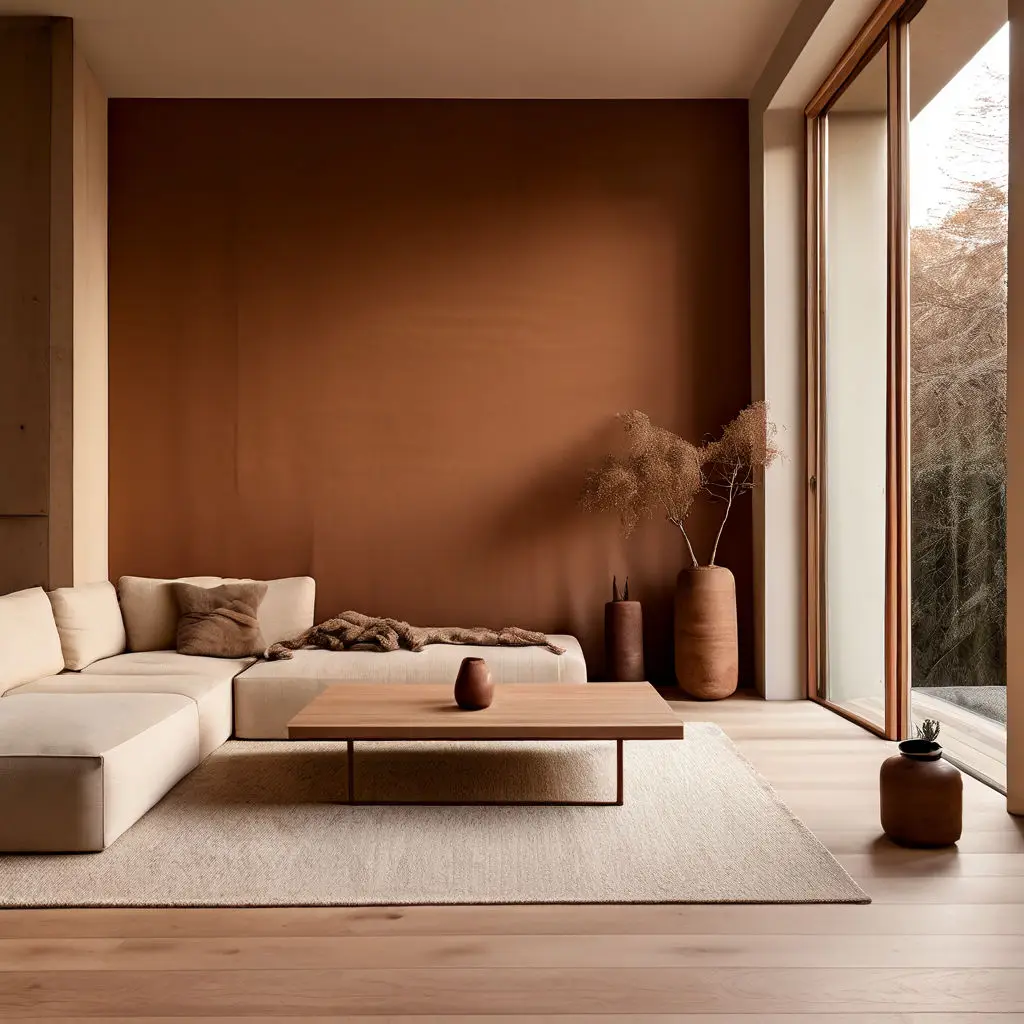


Simplicity in decor is essential for achieving the Japandi style’s minimalist and harmonious look. The focus is on selecting decor items that are not only visually appealing but also serve a functional purpose, contributing to an uncluttered and serene environment.
Here’s how to embrace simplicity in decor:
- Functional Pieces: Choose decor items that have a dual purpose. For example, a stylish yet practical storage basket, a decorative lamp with built-in storage, or a wall-mounted shelf that also serves as a display area for small objects. This approach minimizes clutter while adding aesthetic value.
- Quality over Quantity: Opt for a few high-quality decor items rather than numerous smaller pieces. Select items that have a clean design and superior craftsmanship, as they will make a greater impact without overwhelming the space.
- Neutral Accents: Stick to a color palette that complements the rest of the room. Neutral tones like whites, beiges, and soft grays ensure that decor items blend seamlessly into the space, maintaining a calm and cohesive look.
- Simple Art: Choose artwork that reflects the minimalist ethos of Japandi style. This could be a single, striking piece of art or a series of simple, monochromatic prints. Art should enhance the space without competing with other elements.
- Natural Materials: Incorporate decor items made from natural materials like wood, stone, or ceramics. These materials align with the Japandi style’s emphasis on organic and timeless beauty.
- Minimalist Accessories: Select accessories like candles, vases, or cushions that have simple shapes and understated designs. Avoid overly ornate or colorful items that could distract from the clean lines and serene atmosphere of the space.
By keeping decor items minimal and functional, you enhance the Japandi style’s serene and sophisticated atmosphere, creating a space that feels both elegant and inviting.
10. Natural Light:
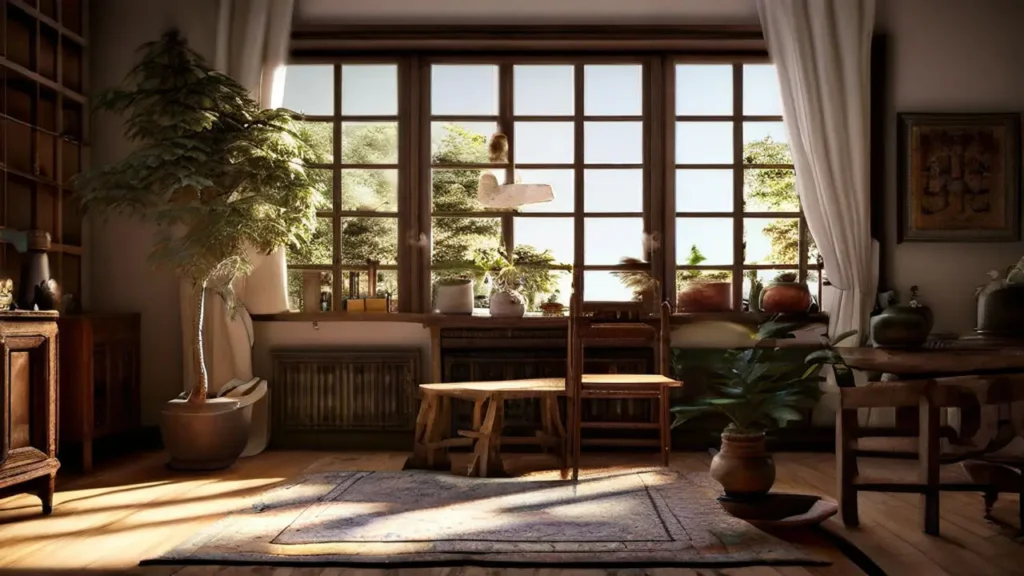




Maximizing natural light is crucial for enhancing the Japandi style’s bright and airy atmosphere. By allowing as much natural light as possible into your space, you create an inviting and serene environment that complements the minimalist and organic elements of Japandi design.
Here’s how to make the most of natural light:
- Sheer Curtains: Opt for sheer or semi-sheer curtains in light, neutral colors. These curtains allow sunlight to filter through while providing a degree of privacy. They help soften the light and prevent harsh glare, maintaining a gentle, diffused illumination throughout the room.
- Blinds: Choose blinds that can be adjusted to control the amount of light entering the space. Minimalist options like bamboo or fabric blinds in neutral tones work well with Japandi style. They can be fully opened to maximize light or partially closed for a softer, more controlled ambiance.
- Reflective Surfaces: Incorporate reflective surfaces, such as glass or polished metal, in your decor to bounce light around the room. This can help amplify natural light and enhance the sense of space and brightness.
- Light Colors: Use light, neutral colors for walls, ceilings, and floors to reflect natural light effectively. Shades of white, beige, or soft gray can help brighten the room and create a more open feel.
- Strategic Placement: Arrange furniture and decor to avoid obstructing windows or light sources. Position larger items away from windows to ensure that light can flow freely throughout the space.
- Clean Windows: Keep windows clean to maximize the amount of natural light that enters your home. Regular cleaning ensures that dust and grime don’t block the light and diminish its effectiveness.
By focusing on these strategies, you can enhance the natural light in your home, contributing to the bright, airy, and tranquil atmosphere that defines the Japandi style.
11. Statement Lighting:





Incorporating statement lighting fixtures that are simple yet elegant can significantly enhance the Japandi style of your home. Here are some options that align perfectly with this aesthetic:
- Pendant Lights: Choose pendant lights with clean lines and minimalist designs. Materials like matte metal, glass, or natural fibers can add a touch of sophistication without overwhelming the space. Opt for a single, well-designed pendant or a cluster of smaller pendants to create a focal point.
- Paper Lanterns: Paper lanterns are a classic choice in Japandi style due to their simplicity and warm, diffused light. They add a soft, serene glow to the room and blend well with the natural and minimalist elements of Japandi decor.
- Simple Chandeliers: If you prefer a chandelier, go for designs with a minimalist approach. Look for chandeliers with clean, geometric shapes and materials like brushed metal or natural wood. They should provide a statement without being overly ornate.
- Sconces: Wall sconces with sleek, unobtrusive designs can provide both functional and ambient lighting. Choose sconces in muted colors or materials that complement your decor while maintaining the overall simplicity of the space.
- Floor Lamps: A minimalist floor lamp with a slender profile and simple shade can add elegance and practicality to your living area. Look for lamps with clean lines and neutral tones that fit seamlessly into your Japandi-inspired space.
By selecting lighting fixtures that are both simple and elegant, you enhance the Japandi style’s emphasis on clarity and calm, creating a beautifully balanced and inviting home environment.



